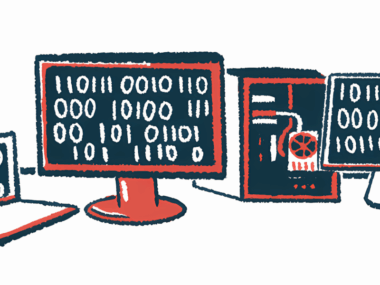#AANAM – Biogen Offers Update on Development Plans for MS Therapies
Written by |

All-focus
At the 2019 annual meeting of the American Academy of Neurology (AAN), Multiple Sclerosis News Today sat down with Bernd Kieseier, MD, global head of multiple sclerosis at Biogen, to discuss the company’s portfolio, latest data, and therapeutic development plans in the field of multiple sclerosis (MS).
Kieseier said there is a need for a personalized approach to treat MS to find the exact therapy for each patient.
“The highlight is clearly our commitment to identifying pathways toward a personalized medicine approach, optimizing the benefit-risk balance for our therapeutics, and taking the field forward by developing and offering new therapies,” Kieseier said.
Neurofilament light as a disease biomarker
This personalized medicine approach “has multiple flavors,” but Kieseier emphasized the possible use of a potential biomarker called neurofilament light chain (NfL), which is released from damaged neurons and, as such, can be a good marker of damage to the nervous system.
“There’s good evidence that [NfL is] a marker you can use to dissect the trajectory of individual patients, like this is a patient that has a rather poor prognosis versus someone who is probably a little bit more stable,” Kieseier said, which might help in the process of decision-making in clinical practice, and allow clinicians to “say, ‘Well, this patient probably needs a different therapy.’ … That’s personalized medicine.”
Discuss the latest research in the MS News Today forums!
NfL holds particular promise because it can be detected in the bloodstream. “You just take a little bit of blood; you can measure it,” he said. This contrasts with other biomarkers that need to be measured in cerebrospinal fluid — the fluid around the brain and spinal cord — through a more invasive method.
But there’s a catch for using NfL as a marker in a clinical setting. “The assay today is too expensive for routine practice,” Kieseier said. “Today we are at the stage where this is kind of an academic exercise … if you really want to drive this forward, you need something that’s available at every corner of the street.”
To address this, Kieseier said, Biogen is partnering with Siemens Healthineers to create an assay that is more cost-effective but still sensitive to provide an accurate diagnosis.
“We’re trying to partner with Siemens to move this forward to a commercially available kit so that, hopefully, one day in any hospital in any practice you can just take the blood, you measure it, and then you get the NfL value that will guide your therapeutic decision with the specific patient in front of you,” he said.
The anti-JCV antibody index and strategies to prevent PML
The personalized approach may also help patients at risk avoid dangerous side effects. One of the approved MS therapies marketed by Biogen, Tysabri (natalizumab), is given by monthly intravenous infusions and works by stopping T cells (a type of immune cell) from accessing the brain, thus preventing inflammation.
Tysabri treatment decreases patients’ annual relapse rate, and slows the appearance and/or enlargement of brain lesions, but the treatment can also make patients susceptible to progressive multifocal leukoencephalopathy (PML), a dangerous brain infection caused by the John Cunningham virus (JCV).
A patient’s level of antibodies against JCV (anti-JCV antibodies) can predict how vulnerable that person is to developing PML.
“The [anti-JCV antibody] index is a tool that defines the risk that you potentially might develop [PML],” Kieseier said, explaining that this can allow doctors and patients to accurately weigh the risks when considering what treatment is best.
“I personally think that natalizumab (Tysabri) is one of the best therapies we have to offer to our patients, but the risk-benefit is a discussion the physician should have with the patient, and the antibody index is a tool to actually discuss the PML risk associated with natalizumab,” he said.
Kieseier also highlighted research presented at AAN showing that extending the interval between each Tysabri dose from four weeks to six weeks — a strategy known as extended-interval dosing (EID) — reduced the risk of PML. Now the question is whether this strategy will still be effective for managing the disease.
“For that reason, Biogen is currently conducting a study called NOVA (NCT03689972),” Kieseier said. “The NOVA study will address the question of what’s happening with patients on efficacy when you just dose every six weeks instead of four weeks.”
Thus, he hopes, patients may have access to a safer treatment strategy, in addition to an effective biomarker.
Oral options: Tecfidera and Vumerity
Kieseier also discussed data on two other Biogen MS therapies: Tecfidera (dimethyl fumarate) and Vumerity (diroximel fumarate; formerly BIIB098 or ALKS 8700).
Tecfidera is an oral medication that reduces the relapse rate, and is approved in the United States and European Union for the treatment of relapsing-remitting MS (RRMS). Vumerity is also an oral therapy, and is currently under review by the U.S. Food and Drug Administration (FDA), with a decision expected this year.
Kieseier said that, if approved, Vumerity may be an alternative for people who can’t or won’t take Tecfidera because of its side effects, primarily gastrointestinal problems.
“If you think about the drug itself, I would look at fumarate as a class, so we don’t feel that there will be a big difference in terms of the efficacy,” he said. “The key … is the tolerability. For those patients that, for whatever reason have difficulties [on Tecfidera], Vumerity may actually represent an option.”
Kieseier does not expect Vumerity to replace Tecfidera in Biogen’s portfolio, though.
“We don’t think it’s one or the other,” he said, because each person with MS is unique. “We’re just offering a new option to the field, so that patients and physicians can decide what the right therapy is” for each patient.
An ongoing clinical trial, EVOLVE-MS-2 (NCT03093324), is directly comparing the tolerability of Tecfidera to that of Vumerity. Results are expected this year; Kieseier declined to comment on interim results. “I don’t want to speculate,” he said. “Let’s wait until we have the data.”
Remyelination: the “long shot” worth working for
Biogen is also working toward what many see to be the ultimate goal for MS therapies: remyelination, or repairing the damage that has already been done to the nervous system.
“All the therapies we have out there are just looking at how can you stop degeneration or how can you stop inflammation,” Kieseier said, “but the open question is: how can you promote repair?”
Biogen is working on therapies such as opicinumab and BIIB061, both aimed at remyelination and assessed in preliminary clinical trials. The results have been somewhat lackluster, but Kieseier thinks this may have less to do with the therapies and more to do with the design of the trials.
“All our endpoints are just looking at damage,” he said. “We don’t have endpoints for repair. So how do you define repair?” This makes it difficult to tell whether or not the therapies are working.
“How can you measure [repair] with the tools we have? Can we measure this clinically? Can we measure this with MRI [magnetic resonance imaging]?”
Kieseier said there is an “ongoing discussion” as further trials, such as a second Phase 2 trial of opicinumab and “other products that also address the component of repair,” are considered and planned for these and similar therapies, including BIIB061.
Designing trials to truly assess repair is still “a work in progress,” Kieseier said, but added that he and colleagues are “super excited” at the prospect of MS therapies that would help the nervous system heal, not just prevent further damage.
“We are convinced in our commitment that we want to promote repair,” he said, “It’s a long shot, but we think it’s important.”





